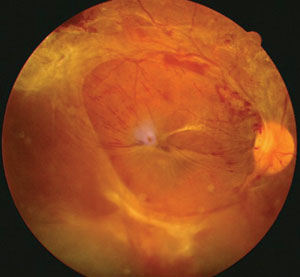Researchers at The Johns Hopkins University and the University of Maryland have discovered that targeting a protein called angiopoietin-like 4 (ANGPTL4) along with VEGF may be the key to improving treatment effectiveness for patients with diabetic retinopathy (DR). New studies document the success of anti-VEGF treatment in delaying the development of proliferative diabetic retinopathy (PDR), but it doesn’t work for all patients—which prompted continued research.
 | |
| This patient exhibited proliferative diabetic retinopathy. Image: Carlo J. Pelino, OD, and Joseph J. Pizzimenti, OD |
To better understand the varying success of anti-VEGF treatment, investigators tested levels of VEGF in eye fluid samples from healthy people, diabetics without diabetic retinopathy and those with varying degrees of DR. They found that some of the fluid collected from patients with PDR had less VEGF than the fluid from healthy participants; however, ANGPTL4 was increased in the fluid of PDR patients, independent of VEGF levels.
Guided by these findings, lead author Savalan Babapoor-Farrokhran, MD, and colleagues took a closer look at ANGPTL4’s involvement in PDR pathogenesis. They found that blocking the action of both ANGPTL4 and VEGF in the fluid from the eyes of PDR patients significantly reduced blood vessel growth.
Researchers hope a new drug can be found that inhibits ANGPTL4 action; it, combined with the anti-VEGF drugs, could prevent many cases of PDR. Encouraged by their findings, the investigators are now exploring whether ANGPTL4 might also play a role in other eye diseases such as macular degeneration.
Babapoor-Farrokhran S, Jee K, Puchner B, et al. Angiopoietin-like 4 is a potent angiogenic factor and a novel therapeutic target for patients with proliferative diabetic retinopathy. Proceedings of the National Academy of Sciences. 2015 May 26. [Epub ahead of print].
